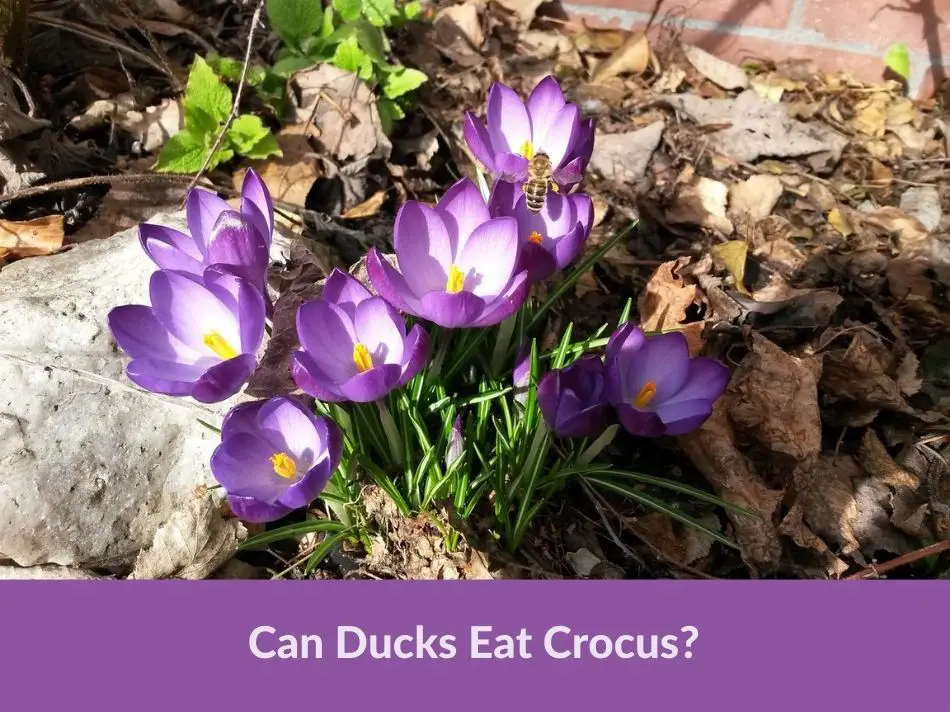Ducks are known for their varied diet, which typically includes a mix of aquatic plants, small fish, insects, and grains. Domestic ducks often enjoy a diet supplemented by commercial feed, providing balanced nutrition. But, can ducks eat crocus?
No, ducks should not eat crocus. The primary toxin is called colchicine and when ingested by ducks it can lead to gastrointestinal distress, multi-organ failure, and potentially, death.
This article examines the toxic properties of crocus plants, the physiological impact on ducks, and considerations for preventing exposure.
The Toxic Principle: Colchicine
Colchicine, the primary toxic agent in crocuses, interferes with cellular function. In ducks, whose feeding habits might lead them to ingest parts of the crocus plant, colchicine can rapidly enter the bloodstream.
Once absorbed, it binds to tubulin, a protein that is integral to cell division, and impedes the formation of microtubules. This disruption halts mitosis, leading to cell death and a cascade of systemic failures.
Clinical Signs of Crocus Poisoning in Ducks
The toxicity of crocus plants manifests in ducks through a series of clinical signs. Initially, affected ducks may display gastrointestinal upset, characterized by vomiting, diarrhea, and abdominal pain.
As the toxin spreads, neurological symptoms can emerge, including tremors, seizures, and disorientation. In the absence of immediate veterinary intervention, these symptoms can escalate to renal and hepatic failure, culminating in fatality.
Incidence and Exposure
Crocus plants bloom in early spring and autumn, times when ducks are actively foraging and may inadvertently consume these toxic flowers. Young shoots and flowers of crocus plants are particularly appealing to ducks, increasing the risk of poisoning during these seasons.
While not all crocus species are equally toxic, the autumn crocus (Colchicum autumnale) is notably dangerous due to its higher colchicine content.
Risk Assessment and Management
Determining the risk crocus plants pose to ducks involves assessing both the prevalence of the plant in the environment and the behavior of the ducks. Migratory patterns can lead flocks to areas with dense crocus plantings, heightening the potential for exposure.
Risk management is crucial, focusing on habitat management, the removal or restriction of crocus plants in duck-frequented areas, and the dissemination of information to those who maintain gardens and parks where ducks are known to visit.
Research and Future Directions
Further research is needed to understand the full impact of crocus toxicity on duck populations and to develop preventative strategies. Studies could explore the possibility of creating crocus varieties with lower levels of colchicine or implementing biological controls that deter ducks from consuming these plants.
Conservationists and scientists must collaborate to ensure that the diverse species of ducks are protected from the hidden dangers of these otherwise enchanting plants.
Other Flowers Ducks Can Eat
While some flowers can pose a risk to ducks, there are many that can be safely consumed and even provide health benefits. Ducks can enjoy a variety of blooms as part of a balanced diet. Edible flowers such as nasturtiums and marigolds are not only safe for ducks but can also add nutritional variety to their diets.
Here is a list of more safe flowers that ducks can eat:
Make sure to see our thorough list of plants and flowers ducks can enjoy.
Conclusion
In conclusion, the toxicity of crocus to ducks is a significant issue that calls for a proactive and informed response. It is imperative that the communities involved in wildlife conservation, horticulture, and land management unite in their efforts to mitigate the risks and preserve the health of duck populations.
Disclaimer: The information in this article is for informational purposes only. I'm not an expert or a veterinarian.


